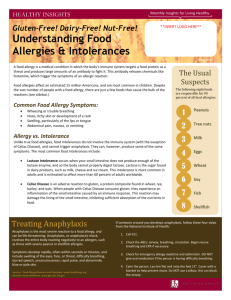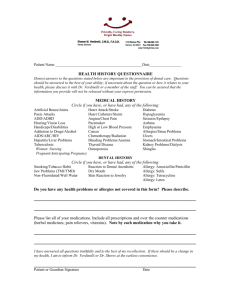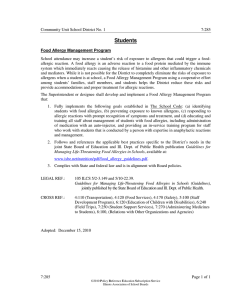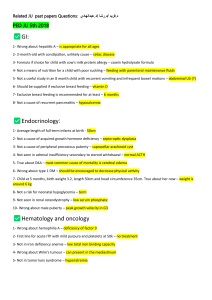Food Allergies.doc
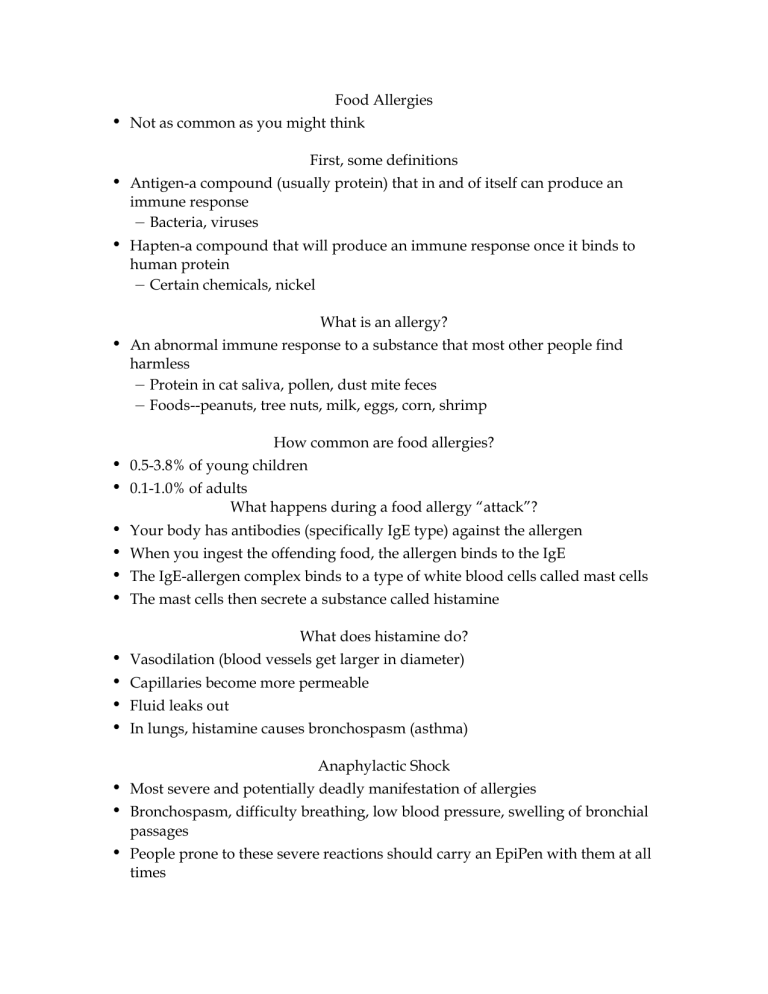
Food Allergies
•
Not as common as you might think
First, some definitions
• Antigen-a compound (usually protein) that in and of itself can produce an immune response
– Bacteria, viruses
•
Hapten-a compound that will produce an immune response once it binds to human protein
– Certain chemicals, nickel
What is an allergy?
•
An abnormal immune response to a substance that most other people find harmless
– Protein in cat saliva, pollen, dust mite feces
– Foods--peanuts, tree nuts, milk, eggs, corn, shrimp
How common are food allergies?
•
0.5-3.8% of young children
•
0.1-1.0% of adults
What happens during a food allergy “attack”?
•
Your body has antibodies (specifically IgE type) against the allergen
•
When you ingest the offending food, the allergen binds to the IgE
• The IgE-allergen complex binds to a type of white blood cells called mast cells
•
The mast cells then secrete a substance called histamine
What does histamine do?
•
Vasodilation (blood vessels get larger in diameter)
•
Capillaries become more permeable
•
Fluid leaks out
•
In lungs, histamine causes bronchospasm (asthma)
Anaphylactic Shock
•
Most severe and potentially deadly manifestation of allergies
• Bronchospasm, difficulty breathing, low blood pressure, swelling of bronchial passages
• People prone to these severe reactions should carry an EpiPen with them at all times
Signs & Symptoms of Food Allergy
•
Gastrointestinal distress-vomiting, diarrhea
•
Children-failure to thrive due to gut symptoms
•
Skin rashes, itching
• Respiratory symptoms are less common, but can occur
Diagnosis of Food Allergy
•
Skin tests
•
RAST test--a blood test
•
Concurrent food and symptom diary
• Elimination of suspect food
•
Double-blind, placebo-controlled food challenge
• Easier said than done!
Management of Food Allergies:
“Just don’t eat it”
How come?
•
“Modified food starch” can be wheat or corn
•
Dry milk or whey, dried egg, and soy can be sneaked into many foods
•
Peanut residues may appear in non-peanut-containing candy
The Food Allergy and Anaphylaxis Network
• www.foodallergy.org
Celiac Disease
•
A unique type of food allergy
•
An allergy to gliadin (component of wheat, rye, barley, and triticale)
Celiac Disease
•
Incidence 1 in 250
• Reaction against small peptides in gliadin that are high in the amino acids glutamine and proline
•
Cannot be detected by RAST test, since IgA is predominant antibody produced
Celiac disease is often undiagnosed for years
•
Villi in small intestine become blunted
•
Result in malabsorption of all nutrients
•
Some people develop bone or skin problems
• Definitive diagnosis-intestinal biopsy and blood test for anti-gliadin antibodies
Treatment of Celiac Disease
•
Lifelong avoidance of foods containing wheat, rye, barley, triticale
•
Another easier said than done concept
•
Celiacs may also be lactose intolerant until villi recover after gliadin abstinence
Another good source of info
• The Celiac Disease Foundation
• www.celiac.org
Food Intolerance
•
A non-immune adverse reaction to a food
Food intolerance examples
• MSG
•
Sulfites--more common in asthma patients
• Lactose intolerance
•
Fructose intolerance
